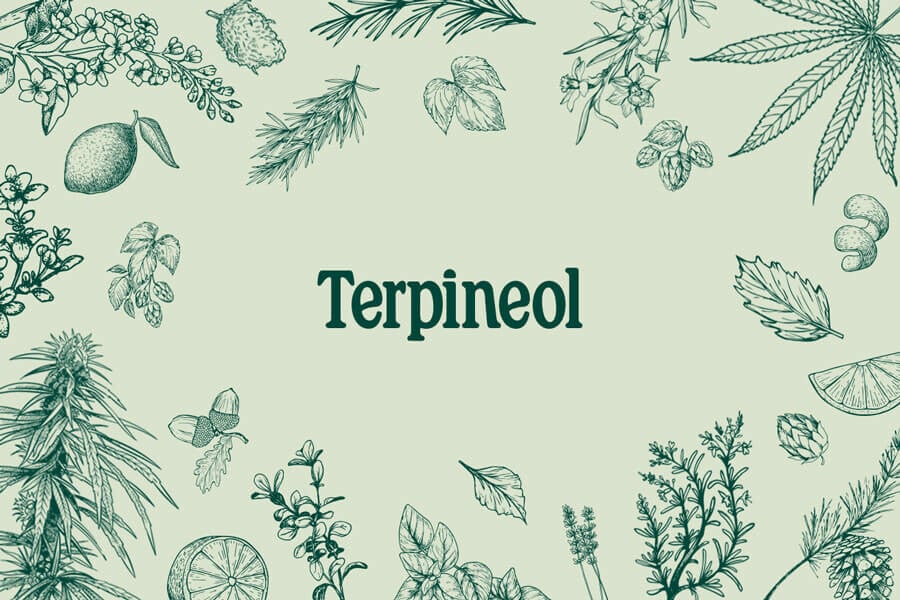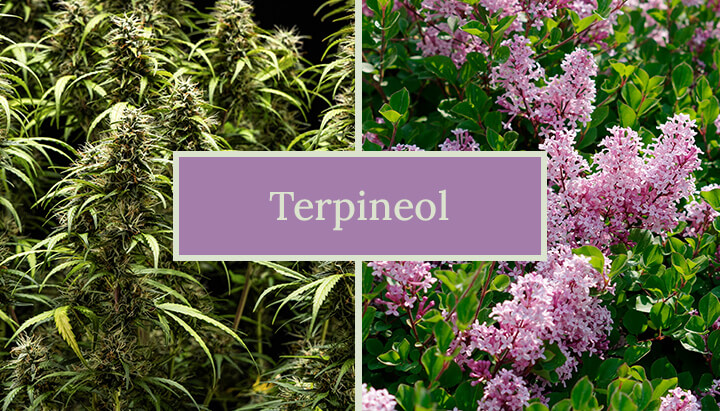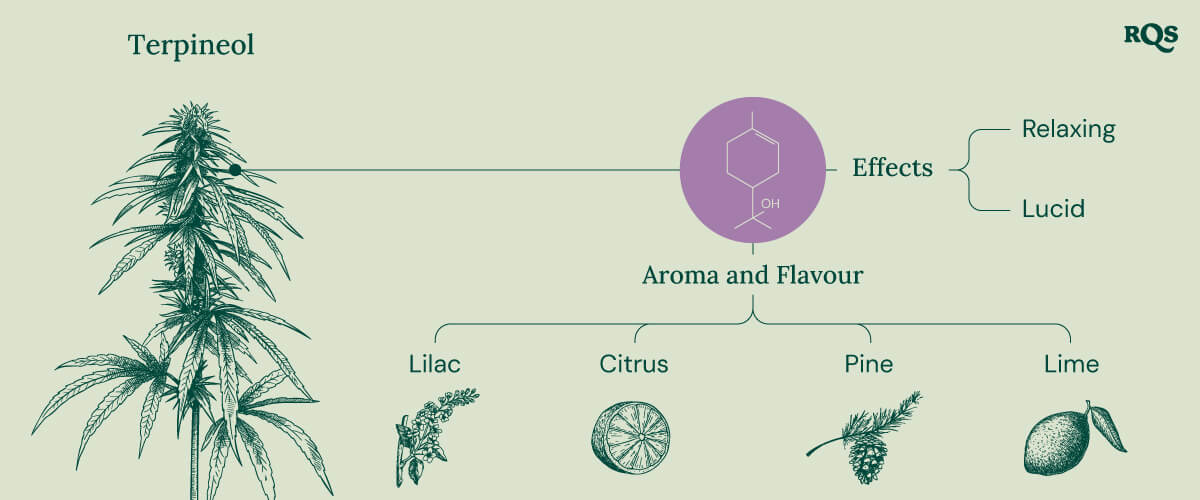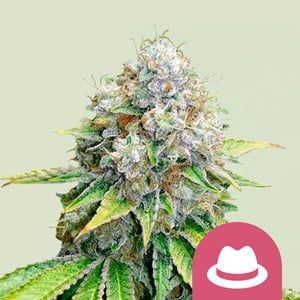.

Terpineol: Get to Know This Mysterious Terpene
You're more than familiar with common cannabis terpenes such as myrcene and pinene. But have you come across terpineol? This mysterious terpene only shows up in small quantities in cannabis strains. However, it has a big impact on their aromas, flavours, and effects. On top of that, it directly influences the human endocannabinoid system.
Contents:
Seen with the naked eye, cannabis buds are little more than clusters of pistillate flowers covered in stigmas, trichomes, and resin. However, with the help of analytical tools, scientists have reframed weed flowers as reservoirs of unique chemical constituents. Alongside over 100 cannabinoids, marijuana flowers produce hundreds of terpenes—aromatic molecules that belong to a chemical category known as secondary metabolites. While they don’t directly contribute to the growth and reproduction of plants, they play a vital role in defense and communication.
But terpenes aren’t unique to cannabis. Around 55,000 of these molecules show up in nature across a wide range of plant species. They’re responsible for the familiar aromas of pine trees, orange peels, rosemary, and many other fruits and herbs. Of the many terpenes that occur in cannabis flowers, several have become particularly sought after for their desirable flavors and effects—including terpineol. Continue reading to get to grips with this fascinating molecule. Discover its chemistry, where else it occurs in nature, and what clinical potential it may pose.
.jpg)

The Chemistry of Terpineol
Terpenes are placed into distinct chemical categories based on their molecular structure. All of these compounds are made up of smaller building blocks known as isoprene units, tiny five-carbon molecules with a formula of C5H8. The smallest group of terpenes, known as monoterpenes, possess just two isoprene units and a total of 10 carbon atoms—cannabis terpenes such pinene, limonene, and terpineol belong to this group. In contrast, the largest group of terpenes, called polyterpenes, feature up to thousands of individual isoprene units.
Terpineol features a chemical formula of C10H18O. However, the terpene exists as several different isomers. Each of those molecules possesses the same chemical makeup but in a different arrangement. They include alpha-terpineol, beta-terpineol, gamma-terpineol, delta-terpineol, and terpinen-4-ol. Of these compounds, alpha-terpineol and terpinen-4-ol are the most abundant in nature. As a group, terpineols are monocyclic monoterpene tertiary alcohols. This means they possess one ring-like structure, two isoprene units, and feature an organic hydroxyl alcohol group.
Compared to the most abundant terpenes found in cannabis flowers, including myrcene and caryophyllene, terpineol shows up in far smaller concentrations. Out of the five compounds that compose this group, alpha-terpineol occurs most frequently in various weed strains. Note that some cannabis users confuse this terpene with terpinene because of their similar names. While both are monoterpenes, these compounds are completely different chemicals with varying aromas and effects.
Does Terpineol Contribute to the Entourage Effect?
Cannabinoids such as THC and CBD are often given the credit when it comes to the effects of cannabis. In actuality, the high experienced when smoking or vaping cannabis is likely triggered by a host of different constituents working in concert. Known as the entourage effect, this phenomenon relies on a chemical synergy between many different chemicals found in weed flowers, including terpenes.
While some researchers have co-administered compounds such as CBD and myrcene and found no evidence[1] of the entourage effect, other studies suggest cannabinoids and terpenes, including terpineol, likely produce a synergistic effect. Both THC and CBD produce their effects by either direct or indirect activation of the endocannabinoid system, a body-wide signalling network that influences many aspects of human physiology, including the central nervous system. For example, THC exerts its psychoactive properties by binding to the CB1 receptor of this system. Interestingly, a 2023 study[2] published in the journal Biochemical Pharmacology tested a handful of cannabis terpenes to see whether they interacted with the CB1 receptor. They concluded that terpineol does indeed activate this site and could modulate the way THC interacts with this receptor.


Where to Find Terpineol
In the case of cannabis plants, alpha-terpineol manufacturing takes place in the trichome glands. More specifically, biochemical pathways synthesise the molecule in the disc cells of glandular trichomes. Then, they’re stored in a cavity between the disc cells and cuticle before being expelled in the form of a viscous resin along with many other cannabis constituents.
However, terpineol isn’t exclusive to cannabis plants. This chemical shows up in numerous other plants including pine trees, flowers such as narcissus and freesia, and herbs such as marjoram, oregano, and rosemary. Alongside cannabis, other members of the Cannabaceae botanical family also produce terpineol, including the flowers of the hops plant grown to flavor countless beers.
Aroma and Taste of Terpineol
You’re now familiar with the chemistry of terpineol and where it occurs in nature. But what flavors and aromas can you expect to encounter when growing and using weed strains high in this terpene? Above all, the chemical has a lilac-like fragrance, which has made it a hit in the cosmetics industry when formulating perfumes and other products. However, smoking or vaping this molecule also unleashes other flavors. Expect subtler notes of pine, citrus, lemon, and lime with each inhalation.
Effects of Terpineol
Weed strains high in terpineol exert a specific effect that’s often associated with “indica” varieties. Alongside THC, terpineol produces a physically relaxing and stoning high that melts the muscles while helping to keep the mind clear and lucid. In concert with other terpenes, alpha-terpineol likely contributes to the “couch-lock” effect characteristic of many weed cultivars. On top of this, users of high-terpineol strains report slowed thoughts, bouts of tranquillity, and the temporary easing of mental worries and agitation.


Terpineol Benefits: A Look at the Research
Building upon the above, we’re now going to acquaint you with some of the scientific literature surrounding terpineol’s physiological influence. While most of the research conducted on alpha-terpineol uses cell and animal models, these studies offer clues as to what human trials could reveal about the molecule in the future.
-
Inflammation
The inflammatory response plays a critical role in recovering from infections and injuries. However, chronic inflammation caused by diet and other environmental factors contributes[3] to a host of modern diseases. In an effort to explore alpha-terpineol’s potential influence on inflammation, researchers from the University of Sergipe, Brazil administered it to a mouse model of the condition. Following application, they assessed inflammatory biomarkers, including nitrite. The team concluded that “this compound might be potentially interesting in the development of new clinically relevant drugs for the management of painful and/or inflammatory disease”.
-
Antibacterial & Antioxidant
Research conducted at the Izmir Institute of Technology, Turkey examined the antibacterial and antioxidant potential of alpha-terpineol. The 2014 study[4], published in the journal Molecules, tested several terpenes commonly found in essential oils against different kinds of bacteria. They administered alpha-terpineol, linalool, alpha-pinene, and eucalyptol to both pathogenic bacteria (those that can infect humans) and spoilage bacteria (the type that rots food). The team found that alpha-terpineol exhibited antioxidant activity while also inhibiting bacteria including Staphylococcus aureus at concentrations of just 0.7%.
-
Neuropathic Pain
A complex condition, neuropathic pain produces symptoms of burning, shooting, and electric shock-like pain. There are various causes of the condition, including nerve damage and dysfunction. A 2022 study[5] published in the journal Psychopharmacology evaluated the effects of three terpenes, including alpha-terpineol, on a mouse model of neuropathic pain. They found each terpene managed to produce a dose-dependent reversal of allodynia (pain provoked by stimuli that don’t typically produce pain) and thermal hyperalgesia (an increased response to heat in injured tissue). After assessing this outcome, the team explored the underpinning mechanism of action and found that CB1 receptors of the endocannabinoid system played a role. They concluded, “The findings suggest that α-terpineol, β-caryophyllene, and γ-terpinene may have differential cannabinoid receptor activity and a pharmacological profile that may yield new efficacious analgesics”.
-
Antifungal
While bacteria certainly receive most of our attention when it comes to infections, several species of fungal pathogens can also attack the human body. These range from superficial infections that affect the skin and hair, such as athlete’s foot and ringworm, to more serious systemic infections that can target internal organs, including Cryptococcosis and Aspergillosis. Scientists continue to search for natural sources of antifungal molecules, and terpenes including alpha-terpineol are possible candidates. A study[6] published in the Journal of Applied Microbiology tested components of tea tree oil, including alpha-terpineol, linalool, and myrcene, against a range of fungi. The researchers concluded that “All tea tree oil components, except beta-myrcene, had antifungal activity”.
-
Antiproliferative
A study[7] published in the International Journal of Oncology set about testing the antiproliferative activity of essential oils from plants belonging to the Magnoliophyta division that are native to the country of Lebanon. While analyzing several different species, the researchers found that alpha-terpineol occurred as a major constituent in Satureja montana essential oil. They went on to test isolated compounds, including alpha-terpineol, on K562 cell lines—leukemia cells originally derived from a cancer patient in 1970. The researchers concluded, “Both caryophyllene and alpha-terpineol showed important antiproliferative effects on K562 cells”.
-
Depression
Terpineol's benefits could also span into the domain of depression if future human trials confirm its effectiveness in this area. However, an early study[8] suggests that the terpene achieves an antidepressant effect in mice by binding to both the CB1 and CB2 receptors of the endocannabinoid system and the D2 dopamine receptor. After performing the research, scientists from the Federal University of Santa Catarina, Brazil concluded, “Our data showed terpineol antidepressant-like modulation by CB1 and CB2 cannabinoid receptors and D2-dopaminergic receptors to further corroborate our molecule evidence”.
Cannabis Strains High in Terpineol
So, exactly what is terpineol used for? Outside of the world of fragrances and cosmetics, the terpene has yet to be used in therapeutic settings. However, you can experience the effects of this captivating compound for yourself right now by using cannabis strains high in this molecule. Check out four strains packed with terpineol below.
-
Royal Jack Auto
To get our list of terpineol strains started, let us introduce you to Royal Jack Auto. To grow this strain, simply sow seeds into 11-litre pots and run your lights for 24 hours per day as soon as sprouts emerge. Apply training on week three to keep your plants at just 40 cm, or leave them untrained to reach a maximum height of 80 cm. Move plants outdoors to a sunny spot or keep them indoors under 24 hours of light per day for rapid growth. During bloom, your plants will develop dense and sticky buds that emit pleasant aromas of earth and pine. Flush your substrate during the last two weeks to improve the flavor of your harvest. Overall, you’ll harvest up to 400 g/m² indoors and 120 g/plant outdoors after a short growing cycle of just 11–12 weeks. After harvest, you’ll enjoy a clear-headed and relaxing high alongside tastes of earth, herbs, pepper, and pine.
Royal Jack Auto
|
|
Jack Herer x Ruderalis |
|
|
12 to 14 oz/m² |
|
|
1 to 3 feet |
|
|
7 - 8 weeks |
|
|
THC: 16% |
|
|
Sativa 40% Indica 30% Ruderalis 30% |
|
|
2 to 4 oz/plant |
|
|
2 to 3 feet |
|
|
11 - 12 weeks after sprouting |
|
|
Creative, Motivating |
-
White Widow
This legendary strain pairs a THC content of 19% with plenty of terpineol. Sow seeds into cell trays and transplant them into their final pots once their true leaves exceed the circumference of each cell. Expect plants to grow up to 10 cm by the end of week two and 15 cm by the end of week three. Apply training techniques now to keep your plants compact yet productive. During bloom, indoor plants will stretch, peaking at 60 cm if trained and 100 cm if untrained. Outdoors, untrained plants grown in large containers have the potential to reach a height of 190 cm. Prepare to harvest up to 500 g/m² indoors after a flowering phase of 8–10 weeks, and 550–600 g/plant outdoors during early October. Brace yourself for a powerful and stoning high when smoking White Widow, accompanied by tastes of pine, spice, and earth.
White Widow
|
|
White Widow S1 |
|
|
16 to 19 oz/m² |
|
|
2 to 3 feet |
|
|
8 - 10 weeks |
|
|
THC: 19% |
|
|
Sativa 50% Indica 50% |
|
|
19 to 21 oz/plant |
|
|
5 to 6 feet |
|
|
Early October |
|
|
Powerful , Stoned |
-
OG Kush
Many weed users have smoked OG Kush for years without knowing it contains a good amount of terpineol. The compound partly underpins the clear-headed and relaxing effects of this offspring of Chemdawg, Lemon Thai, and Pakistani Kush. Sow seeds directly into 15–20-litre pots and expect them to grow to 130 cm indoors and 180 cm outdoors by the end of veg. During bloom, plants will stretch to 160 cm and 220 cm respectively. Watch as the buds swell and start to emanate a pungent aroma as plants near harvest. Flush your substrate during the final 1–2 weeks and prepare to harvest up to 475 g/m² indoors and 550 g/plant outdoors after a flowering phase of 7–9 weeks. After drying and curing your buds, you’ll enjoy a peaceful high alongside flavors of pine, citrus, and fruit.
OG Kush
|
|
Chemdawg x Lemon Thai x Pakistani Kush |
|
|
15 to 17 oz/m² |
|
|
3 to 5 feet |
|
|
7 - 9 weeks |
|
|
THC: 19% |
|
|
Sativa 25% Indica 75% |
|
|
18 to 19 oz/plant |
|
|
6 to 7 feet |
|
|
October |
|
|
Calming, Uplifting |
-
Royal Cookies
Royal Cookies combines big buds, a THC content of 23%, and large yields with high concentrations of terpineol. Sow seeds directly into 10–20-litre pots and keep temperatures and humidity high for quick germination. Stay on top of defoliation throughout veg to keep the canopy aerated and open. Expect your plants to reach a height of up to 140 cm by the end of veg as they start putting out pre-flowers. During bloom, prepare to watch your plants stretch to heights of up to 180 cm. Make sure you have enough stash jars to store up to 525 g/m² from indoor plants and up to 500 g/plant from outdoor plants after a flowering phase of 8–9 weeks (October harvest outdoors). When the time comes to blaze up your buds, you’ll experience a euphoric and physically relaxing effect alongside sweet and earthy flavors.
Royal Cookies
|
|
Forum Cookies S1 |
|
|
16 to 18 oz/m² |
|
|
3 to 4 feet |
|
|
8 - 9 weeks |
|
|
THC: 23% |
|
|
Sativa 20% Indica 80% |
|
|
16 to 18 oz/plant |
|
|
5 to 6 feet |
|
|
Middle of October |
|
|
Euphoric, Physically Relaxing |
Terpineol: A Fascinating Terpene With Serious Potential
And just like that, you're well acquainted with one of the most fascinating compounds found in cannabis flowers. Terpineol adds earthy and piney tastes to select weed strains and also contributes to their stoning and cerebral effects. Emerging studies also suggest that the molecule could have some serious clinical potential, but large human trials are needed to confirm these findings. Overall, research on terpineol has helped to add evidence to the entourage effect theory, with the terpene triggering both major receptor sites of the human endocannabinoid system. So, go and enjoy some high-terpineol flowers and revel in their effects!
- Anti-Inflammatory and Analgesic Properties of the Cannabis Terpene Myrcene https://www.mdpi.com
- α-Terpineol, a natural monoterpene: A review of its biological properties https://www.degruyter.com
- Chronic inflammation in the etiology of disease across the life span | Nature Medicine https://www.nature.com
- Antibacterial and Antioxidant Activity of Essential Oil Terpenes https://www.ncbi.nlm.nih.gov
- Evaluation of the terpenes β-caryophyllene, α-terpineol, and γ-terpinene https://link.springer.com
- Antifungal activity of the components of Melaleuca alternifolia (tea tree) oil - PubMed https://pubmed.ncbi.nlm.nih.gov
- Antiproliferative activity of essential oils derived from plants https://pubmed.ncbi.nlm.nih.gov
- Antidepressant-Like Effect of Terpineol in an Inflammatory Model of Depression https://www.researchgate.net



















































